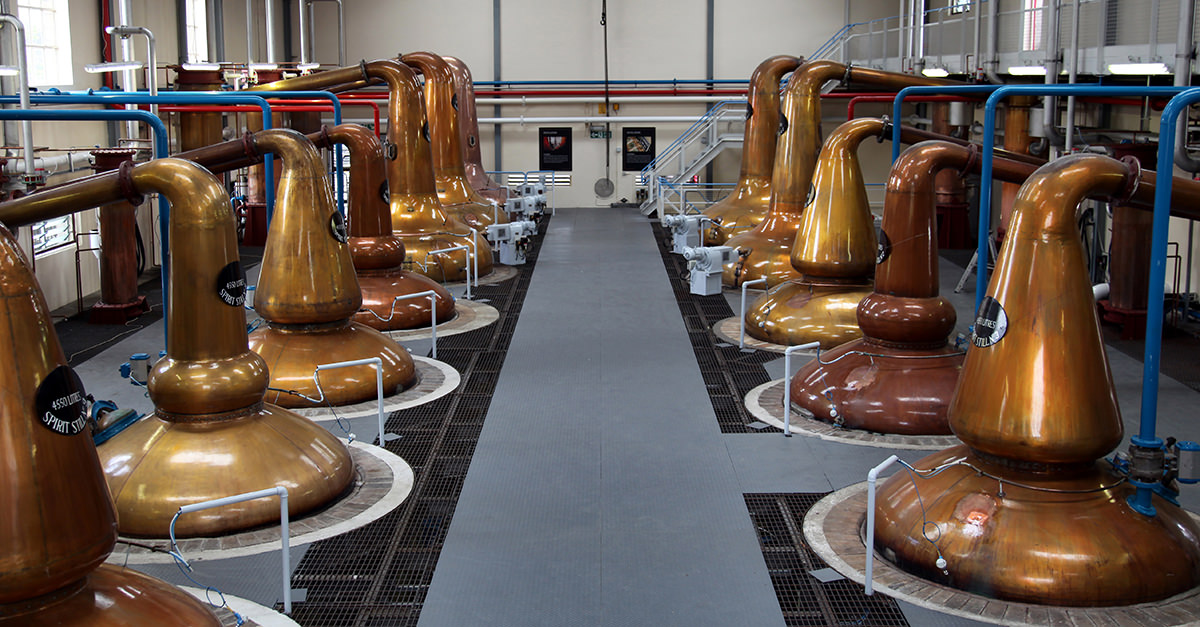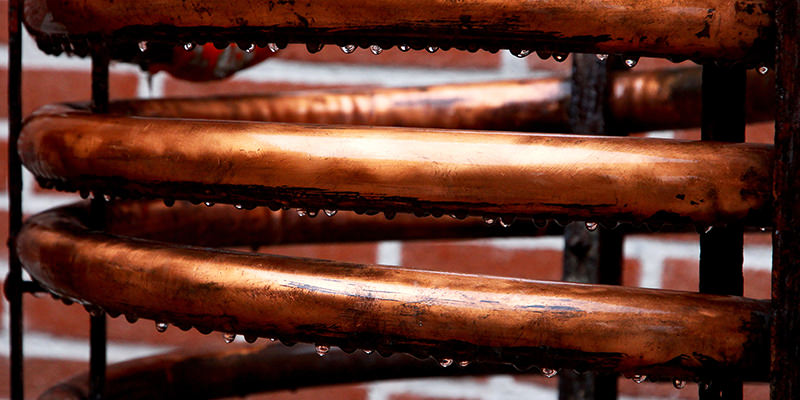A modern distillery kind of looks like it belongs somewhere in the Chocolate Factory (maybe adjacent to the “Fizzy Lifting Drink” room?): depending on what’s being distilled, there might be tall gleaming columns connected by a network of tubes, or massive, squat pots that look like giant copper Hershey Kisses. Believe it or not, these pumps and valves and shiny metal fixtures make up the carefully controlled mechanism behind your favorite whisk(e)y. Or gin. Or Strawberry Colada Svedka Vodka. No judgments.
While the history of distilling is actually tied to the history of alchemy—yes, we owe liquid confidence to an ancient mystical science—the basic concept of distilling has always been pretty simple: making a harder alcohol from a lower alcohol base. But why do we have to distill hard liquor? Why can’t we just keep fermenting it to higher and higher ABVs? As often happens in the science of booze, it’s all about the yeast. As yeast eat up the sugars (to make beer or wine, e.g.), they create alcohol and CO2, delightful waste products. But the more alcohol and CO2 they create, the less sugar there is for them to feed on. And at a certain point (around 14 to 18% ABV), the alcohol levels become toxic for the yeast. To create anything substantially “hard,” we can’t rely on yeast. To get high ABV alcohol, we have to actually physically separate alcohol from water using evaporation and condensation—aka distilling.
Because alcohol has a lower boiling point than water (173 F vs. 212 F), distillers can evaporate the alcohol (mostly) by itself, collect the vapors into a tube and use cold temperatures to force the alcohol to condense back into liquid. In all of drinking history, just two methods of distilling have evolved:
Alembic, or “pot distilling,” was the first method in history (first used in alchemy). The “alembic” itself is the big kettle-shaped vessel where the primary fermented liquid, also known as a “wash” (or a “mash”), is heated up. Ethanol evaporates before water, traveling into a cooling tube and back into another vessel to condense. Less water present means higher ABV, hooray! But the ethanol isn’t necessarily alone in there. Compounds called congeners (e.g. esters, tannins, methanol, fusel alcohols) also evaporate during distilling, and can impact the flavor. The art of distilling is making sure you get the right amount of alcohol and any desirable congeners or flavoring compounds into the final product.
Column Distilling came out of the success of pot distilling. By the 19th century, commercial distillers were looking for a faster distilling method (the pot stills had to be washed after every batch). Robert Stein and Aeneas Coffey separately invented and improved upon the process of “column distilling,” which actually involves giant gleaming columns (they can reach stories high). In column distilling, the mash or wash is continuously injected into the column, with steam constantly rising up to meet it. The steam is programmed to be at the perfect temperature to strip alcohol from the wash and leave undesired compounds behind as it rises up through the column. Column distilling not only requires no cleaning between batches, the structure of the columns (and the ability to have several columns for alcohol vapors to continuously flow and refine through) allows for efficient, repeated distilling—which is why column distilling results in more neutral, higher ABV spirits than pot distilling (think vodka). And while not all column-distilled spirits are repeatedly distilled, some claim to have been distilled as many as 34 times.
Again, however you are distilling, alcohol never evaporates alone. Congeners (tannins, esters, fusel alcohols, and even methanol) can evaporate with it. Cutting is the process by which the distiller separates out these elements, usually through careful temperature and timing control. For instance, methanol (the stuff behind the “moonshine makes you go blind” legends) evaporates at 148.5 F, so a distiller can conclude any liquid that shows up before 173 F (the boiling point of safe, delightful ethanol) should be discarded. Meanwhile, fusel alcohols (also known as “fusel oils” for their oily texture) can come at the end or “tail” of the distillation run, and are often discarded (or sent back in for redistilling). The basic cycle of distilling can be divided into the “fores,” “head,” “heart,” and “tail”—also known as “fractions”—with the heart being the most desirable component. The distiller’s work is kind of like a mixture of extreme precision, and no doubt a bit of old school intuition.

